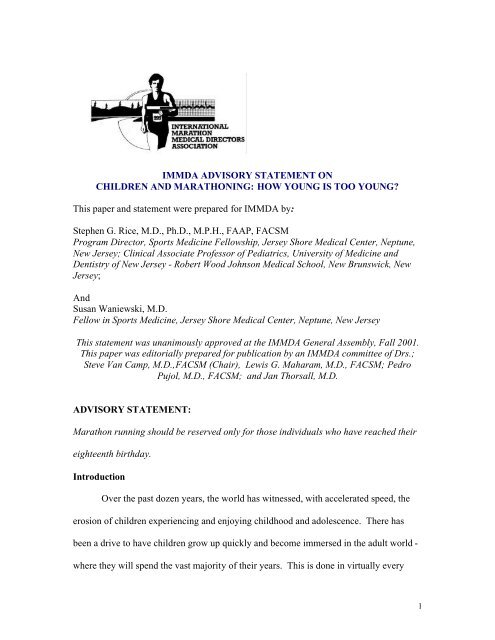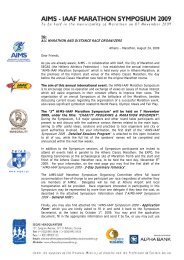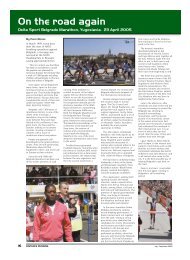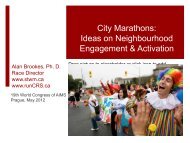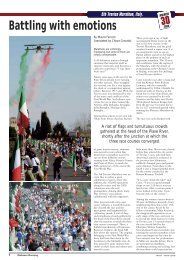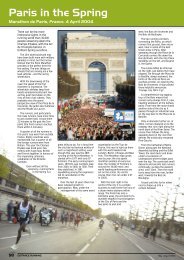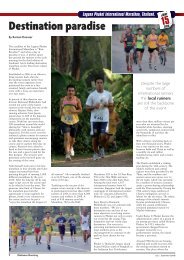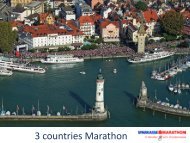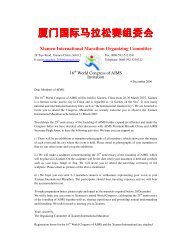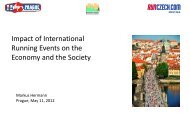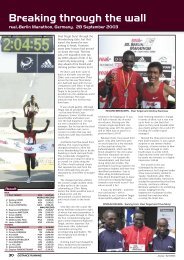Children and Marathoning Final Version 11.02 - AIMS
Children and Marathoning Final Version 11.02 - AIMS
Children and Marathoning Final Version 11.02 - AIMS
You also want an ePaper? Increase the reach of your titles
YUMPU automatically turns print PDFs into web optimized ePapers that Google loves.
IMMDA ADVISORY STATEMENT ON<br />
CHILDREN AND MARATHONING: HOW YOUNG IS TOO YOUNG?<br />
This paper <strong>and</strong> statement were prepared for IMMDA by:<br />
Stephen G. Rice, M.D., Ph.D., M.P.H., FAAP, FACSM<br />
Program Director, Sports Medicine Fellowship, Jersey Shore Medical Center, Neptune,<br />
New Jersey; Clinical Associate Professor of Pediatrics, University of Medicine <strong>and</strong><br />
Dentistry of New Jersey - Robert Wood Johnson Medical School, New Brunswick, New<br />
Jersey;<br />
And<br />
Susan Waniewski, M.D.<br />
Fellow in Sports Medicine, Jersey Shore Medical Center, Neptune, New Jersey<br />
This statement was unanimously approved at the IMMDA General Assembly, Fall 2001.<br />
This paper was editorially prepared for publication by an IMMDA committee of Drs.;<br />
Steve Van Camp, M.D.,FACSM (Chair), Lewis G. Maharam, M.D., FACSM; Pedro<br />
Pujol, M.D., FACSM; <strong>and</strong> Jan Thorsall, M.D.<br />
ADVISORY STATEMENT:<br />
Marathon running should be reserved only for those individuals who have reached their<br />
eighteenth birthday.<br />
Introduction<br />
Over the past dozen years, the world has witnessed, with accelerated speed, the<br />
erosion of children experiencing <strong>and</strong> enjoying childhood <strong>and</strong> adolescence. There has<br />
been a drive to have children grow up quickly <strong>and</strong> become immersed in the adult world -<br />
where they will spend the vast majority of their years. This is done in virtually every<br />
1
phase of their young lives, often by caring parents <strong>and</strong> communities, without a true<br />
underst<strong>and</strong>ing of the developmental <strong>and</strong> emotional needs of childhood <strong>and</strong> adolescence.<br />
Justification for such thinking comes from the notion that "Life is competitive,<br />
life is 'a race'. We must start early on that path to ultimate success." Examples of such<br />
misconceptions, myths <strong>and</strong> inappropriate expectations begin almost from birth, progress<br />
through infancy <strong>and</strong> early childhood, <strong>and</strong> culminate in adolescence. They are seen in<br />
areas of learning, eating <strong>and</strong> physical activity. And so it is with the notion that running a<br />
marathon race of 26.2 miles is a sensible <strong>and</strong> appropriate activity for those youngsters<br />
less than eighteen years of age.<br />
<strong>Children</strong> are not small adults. Their anatomy <strong>and</strong> physiology are developing <strong>and</strong><br />
not fully mature. Despite these concepts which are intuitively understood in the broadest<br />
sense, in practice, <strong>and</strong> especially in athletic pursuits, these distinctions are forgotten or<br />
ignored.<br />
The focus of discussion for some may be exclusively about whether participating<br />
in marathon events is detrimental physically to participants. This statement, however,<br />
will review the medical literature also in regard to whether there are emotional <strong>and</strong><br />
developmental issues which should also play a major role in determining the policy<br />
regarding young athletes running in full length marathons.<br />
Background<br />
The American Academy of Pediatrics Committee on Sports Medicine <strong>and</strong><br />
Fitness has published various statements in recent years regarding reasonable guidelines<br />
for youth participation in physical activity. One such statement published by the<br />
2
American Academy of Pediatrics (AAP) in May 2000 addresses the benefits of physical<br />
fitness <strong>and</strong> activity in schools (1). The key point of this statement is that positive health<br />
related behaviors acquired in childhood are more likely to be carried into adulthood<br />
(1,2,3). Thus, aerobic distance running for fitness as a child can clearly be beneficial to<br />
one's health as an adult (1,4). However, such fitness can be attained without ever<br />
approaching the rigors of training <strong>and</strong> distance covered in preparing for <strong>and</strong> running in<br />
marathons (5).<br />
In another such statement in June 2001 titled "Organized Sports for <strong>Children</strong> <strong>and</strong><br />
Preadolescents", the AAP committee outlines clear recommendations for childhood<br />
involvement in organized sports (6). The overall suggestion is to set reasonable goals for<br />
the child including acquire basic motor skills, increase physical activity levels, learn<br />
social skills to work as a team, learn good sportsmanship <strong>and</strong> have fun. One could<br />
contend that marathon participation could meet many of these goals. However, in this<br />
same statement, the AAP committee implies that sporting activity should be geared to<br />
meet the developmental level of children <strong>and</strong> adolescents in regard to their physical<br />
abilities, cognitive capacities, initiative <strong>and</strong> interest (6,7). This is not possible for a child<br />
marathoner. Emotional burnout is a real phenomenon that can have the exact opposite<br />
effect of that intended by participation. <strong>Children</strong> may develop feelings of failure <strong>and</strong><br />
frustration when the dem<strong>and</strong>s, both physical <strong>and</strong> cognitive, exceed their internal<br />
resources.<br />
Yet another statement published by the AAP in July 2000 addresses intensive<br />
training <strong>and</strong> sports specialization in young athletes (8). This statement warns against<br />
early specialization due to negative psychological effects. Most athletes report elite-<br />
3
level competition to be a positive experience, but early specialization leads to less<br />
consistent performance, more injuries, <strong>and</strong> shortened sports careers than those who<br />
specialize after puberty (8, 9).<br />
In their statement on triathlon participation by children in 1996, the AAP<br />
Committee on Sports Medicine <strong>and</strong> Fitness recognizes that children younger than18 years<br />
require shorter distances of competition <strong>and</strong> specific guidelines to protect children from<br />
harm in competitions designed for adults (10). The AAP statement clearly delineates<br />
safety precautions to be followed in designing such a competition. Their<br />
recommendations state that triathlons for children <strong>and</strong> adolescents, like all other<br />
activities, should be specifically designed to meet their needs <strong>and</strong> provide "safety, fun<br />
<strong>and</strong> fitness rather than competition." The distances for each of the three events are<br />
significantly below those used by adults; further, there are distance categories for those<br />
aged 7 to 10; those aged 11 to 15, <strong>and</strong> those aged 15 to 19. The AAP statement outlines<br />
safety guidelines, including: tapering events in accordance with weather conditions,<br />
requiring a pre-event swim test, requiring an appropriate number of lifeguards for the<br />
swim, holding the swim in pools of appropriate temperature water rather than in open<br />
waters, closing off the bicycle course to motor vehicles, m<strong>and</strong>ating bicycle helmet use,<br />
providing adequate fluids during <strong>and</strong> after competition, preparing to h<strong>and</strong>le medical<br />
problems or emergencies, <strong>and</strong> screening all athletes prior to competition (10). These<br />
recommendations underscore the concept that it is appropriate <strong>and</strong> necessary to provide<br />
clear guidelines <strong>and</strong> modifications for participation by a child in an "adult" event.<br />
A clear-cut physical barrier to marathon running in children is the decreased<br />
ability to withst<strong>and</strong> climatic heat stress by the exercising child or adolescent (11, 12, 13).<br />
4
The data (enumerated in a 2000 AAP Sports Medicine <strong>and</strong> Fitness Committee statement)<br />
show that children do not adapt to heat stress as well as adults for several reasons.<br />
<strong>Children</strong> have a greater body surface area to body mass ratio than adults (11, 14);<br />
therefore, children gain more radiant heat on a hot day <strong>and</strong> lose more heat to the<br />
surrounding environment on a cool day compared to adults. <strong>Children</strong> also produce more<br />
metabolic heat per unit of body mass, <strong>and</strong> have a lower sweating capacity, resulting in a<br />
decreased ability to dissipate metabolic heat (12, 15, 16). A child takes longer to<br />
acclimatize to heat than the adult (11). <strong>Final</strong>ly, the capacity to convey body heat by<br />
blood from the body core to the skin is reduced in the exercising child. Thus children are<br />
subject to a greater increase in core temperature during endurance activities than are<br />
adults.<br />
Overuse Injuries<br />
Long distance running places high mechanical loads on the skeleton, both from<br />
ground reactive forces associated with gravity <strong>and</strong> muscle contractions. While walking,<br />
an individual is confronted with a ground reactive force equal to one's body weight.<br />
While running, however, these gravitational forces increase to between three <strong>and</strong> six<br />
times body weight, depending on whether one runs on flat surfaces or hilly terrain <strong>and</strong><br />
also on the length of one's stride (especially when going downhill). A runner will l<strong>and</strong> on<br />
each leg between 500 <strong>and</strong> 1000 times per mile, again depending on stride length.<br />
The majority of injuries suffered by marathon runners are overuse injuries (17, 18,<br />
19). It is well established that overuse injuries are of multi-factorial etiology, <strong>and</strong> many<br />
of these common risk factors for overuse injuries exist among both children <strong>and</strong> adults.<br />
5
Risk factors unique to the growing child are numerous. It is well known that<br />
stress fractures, a distinct overuse injury, are a function of the number of repetitions <strong>and</strong><br />
amount of applied force per repetition (17). Clearly, a child with shorter stride length<br />
subjects himself to more repetitions of impact to cover the same distance as an adult.<br />
Immature articular cartilage is more susceptible to shear force than adult cartilage <strong>and</strong><br />
predisposes children to osteochondritis dissecans (20, 21). It has also been shown in<br />
studies by Stulber <strong>and</strong> Harris that injuries to the growth plate from repetitive trauma are<br />
possible etiologic factors in adult onset arthritis of the hip (20, 22, 23). <strong>Children</strong> are also<br />
prone to injury at apophyses such as the tibial tubercle, resulting in Osgood-Schlatter<br />
disease, <strong>and</strong> the calcaneus, resulting in Sever's disease (20, 24). A final characteristic of<br />
children that predisposes them to overuse injury is the asynchrony of bone growth <strong>and</strong><br />
muscle-tendon elongation. During periods of rapid growth, bone growth occurs first with<br />
delayed muscle tendon elongation <strong>and</strong> resultant decreased flexibility (20, 25).<br />
For the safety of young runners, it is imperative that the training program <strong>and</strong> its<br />
progression be followed closely <strong>and</strong> monitored carefully. From injury surveillance data<br />
conducted on high school athletes in Seattle over a fifteen year period, the activity with<br />
the highest rate of injuries was girls cross-country; this injury rate was statistically<br />
significantly higher than the other known "high risk sports" of football, wrestling <strong>and</strong><br />
gymnastics (26, 27, 28, 29). Boys cross-country also had a surprisingly high rate of<br />
injuries, placing fifth overall (behind girls cross-country, football, wrestling <strong>and</strong> girls<br />
soccer). Distance running among adolescent boys <strong>and</strong> girls is thus associated with a<br />
relatively high rate of injury. For these athletes, the competitive distance is no more than<br />
3 miles (27, 28, 29). Thus, training to run in a marathon, which is more than eight times<br />
6
the usual cross-country competitive racing distance, is an inappropriate activity for young<br />
persons.<br />
Newspaper articles about injuries in cross country running sprouted up after the<br />
Seattle high school injury surveillance study was publicized in the lay press (26). Several<br />
of these featured stories about injuries to young promising cross country runners, whose<br />
careers were cut short because of recurrent significant overuse injuries. Among<br />
orthopedic surgeons, some have expressed concern that athletes encouraged to do<br />
intensive running prior to skeletal maturity may be predisposed to degenerative diseases<br />
of the joints <strong>and</strong> cartilage as adults (30).<br />
Thus among young athletes, preparing for a marathon is ill advised. In this<br />
population, more is not better; there is ample time to increase one's mileage <strong>and</strong> personal<br />
goals when athletes begin college competition at approximately age eighteen.<br />
Psychological Considerations<br />
Many athletes involved in intensive athletic endeavors (which by its very nature<br />
marathon participation is) experience emotional burnout <strong>and</strong> loss of self-esteem, losing<br />
interest in the very activity that dominated their childhood <strong>and</strong> early adolescent years.<br />
Much attention has been given to the issue of psychological effects of marathon<br />
running on child participants in the lay press. NBC Nightly News profiled a family<br />
during a summer 1988 broadcast (31), with five children (ages 6-16 years), all of whom<br />
participate in distance running, with training that includes running seven days per week.<br />
This family has been often used in the lay press in arguments for <strong>and</strong> against youth<br />
participation in marathons (32, 33). Reports of this family <strong>and</strong> other families claim that<br />
7
the running regimen is the child's idea, <strong>and</strong> that each child truly enjoys this activity.<br />
Society, however, accepts the concept that below certain ages, a child is incapable of<br />
giving true consent. Heretofore, races have been "sanctioning" these activities by<br />
allowing children to compete in marathons, thus providing an avenue of encouragement<br />
for this behavior. The fact that marathon record times for children in age groups below<br />
10 <strong>and</strong> between 10 <strong>and</strong> 13 exist only serve to fuel the desire to compete <strong>and</strong> better that<br />
record. Marathon running is a serious activity, one that is generally recognized as<br />
stressful to all who engage in it. Subjecting children to the stresses of marathon running<br />
<strong>and</strong> training is not healthful.<br />
Female Athlete Triad<br />
Participation in certain sports predisposes female athletes to developing the<br />
female athlete triad (34). This triad consists of three interrelated conditions: disordered<br />
eating, amenorrhea, <strong>and</strong> osteoporosis, <strong>and</strong> is directly associated with intense athletic<br />
training (35, 36, 37). Sports which place athletes at higher risk of developing this<br />
condition include those in which: (a) thinness is emphasized, such as gymnastics, figure<br />
skating, diving, synchronized swimming <strong>and</strong> ballet; (b) those in which leanness is<br />
believed to improve performance, such as long distance running, swimming <strong>and</strong> cross<br />
country skiing; <strong>and</strong> (3) those in which weight classification exists, such as wrestling,<br />
martial arts <strong>and</strong> rowing (34). Marathon participation clearly is an activity which can lead<br />
to the female athlete triad.<br />
Approaches of Other Organizations<br />
8
The sport of tennis confronted similar issues during the mid-1990s regarding the<br />
age at which athletes should be allowed to compete in tournaments. Such regulations<br />
were initiated because of the burnout problems of Jennifer Capriati <strong>and</strong> the impending<br />
rise of Venus <strong>and</strong> Serena Williams. The USATF limited the ages <strong>and</strong> number of<br />
tournaments the participants could engage in. The results have been quite positive.<br />
Jennifer Capriati personally shook off her "lost years" to return to championship form<br />
<strong>and</strong> the Williams sisters, forced to conform to restricted opportunities as children, are<br />
now the dominant forces in the women's tennis game today. The actions of the USATF<br />
were implemented after seeking expert medical opinions regarding the physical, mental<br />
<strong>and</strong> developmental nature of potential problems associated with unrestricted competition<br />
by young girls.<br />
Conclusion<br />
Adults <strong>and</strong> parents are often called upon in our society to set limits <strong>and</strong> guidelines<br />
for precocious <strong>and</strong> dem<strong>and</strong>ing children. It is in the overall best interests of our children<br />
to make participation in a full marathon an adult activity, reserved only for those 18 years<br />
of age <strong>and</strong> above. Ample number of opportunities exist after eighteen years of age to<br />
participate in this exhilarating experience of marathon running.<br />
While it is conceivable that given proper biomechanics <strong>and</strong> anatomy, a quality<br />
progressive training program, <strong>and</strong> appropriate maturity <strong>and</strong> cognitive level, a long<br />
distance runner can have a positive experience from participating in marathons prior to<br />
eighteen years of age. This special individual would be the exception <strong>and</strong> not the rule.<br />
Examples of such individuals do exist, but serve to demonstrate that decisions rendered<br />
9
egarding participation are not designed with the "exception to the rule" as the critical<br />
parameter.<br />
References<br />
1. American Academy of Pediatrics, Committee on Sports Medicine <strong>and</strong> Fitness <strong>and</strong><br />
Committee on School Health. Physical Fitness <strong>and</strong> Activity in Schools. Pediatrics<br />
105:1156-57, 2000.<br />
2. Centers for Disease Control <strong>and</strong> Prevention. Guidelines for school <strong>and</strong> community<br />
programs to promote lifelong physical activity among young people. MMWR<br />
(Morbidity Mortality Weekly Report) 46(RR-6): 1-36, 1997.<br />
3. Sallis JF, ed. Physical activity guidelines for adolescents. Pediatric Exercise Science<br />
6 (special issue) 299-463, 1994.<br />
4. M<strong>and</strong>igout S, Lecoq AM, Courteix D, Guenon P, <strong>and</strong> Obert P. Effect of Gender in<br />
Response to an Aerobic Training Programme in Prepubertal <strong>Children</strong>. Acta<br />
Paediatrica 90: 9-15, 2001.<br />
5. Abe D, Yanagawa K, Yamanobe K, Tamura K. Assessment of middle-distance<br />
running performance in sub-elite young runners using energy cost of running. Eur J<br />
Appl Physiol 77: 320-325, 1998<br />
6. American Academy of Pediatrics, Committee on Sports Medicine <strong>and</strong> Fitness <strong>and</strong><br />
Committee on School Health. Organized Sports for <strong>Children</strong> <strong>and</strong> Preadolescents.<br />
Pediatrics 107:1459-61, 2001.<br />
7. Martens R., Seefeldt V, eds. Guidelines for <strong>Children</strong>'s Sports. Reston, VA: National<br />
Association for Sport <strong>and</strong> Physical Education (NASPE): 1-47, 1979.<br />
10
8. American Academy of Pediatrics, Committee on Sports Medicine <strong>and</strong> Fitness.<br />
Intensive Training <strong>and</strong> Sports Specialization in Young Athletes. Pediatrics 106: 154-<br />
157, 2000.<br />
9. Bompa T. From Childhood to Champion Athlete. Toronto, Canada: Veritas<br />
Publishing, Inc; 1995.<br />
10. American Academy of Pediatrics, Committee on Sports Medicine <strong>and</strong> Fitness.<br />
Triathlon Participation by <strong>Children</strong> <strong>and</strong> Adolescents. Pediatrics 98:511-512, 1996.<br />
11. American Academy of Pediatrics, Committee on Sports Medicine <strong>and</strong> Fitness.<br />
Climatic Heat Stress <strong>and</strong> the Exercising Child <strong>and</strong> Adolescent. Pediatrics 106:158-<br />
159, 2000.<br />
12. Bar-Or O. Temperature regulation during exercise in children <strong>and</strong> adolescents.<br />
Perspectives in Exercise Sciences <strong>and</strong> Sports Medicine, II. Youth, Exercise <strong>and</strong><br />
Sport. Indianapolis, IN: Benchmark Press; 1989:335-367.<br />
13. Wagner JA, Robinson S, Tzankoff SP, et al. Heat tolerance <strong>and</strong> acclimatization to<br />
work in the heat in relation to age. J Appl Physiol 33:616-622, 1972.<br />
14. Astr<strong>and</strong> PO. Experimental Studies of Physical Working Capacity in Relation to Sex<br />
<strong>and</strong> Age. Copenhagen, Denmark: Munksgaard: 1952.<br />
15. Haymes EM, McCormick RJ, Buskirk ER. Heat tolerance of exercising lean <strong>and</strong><br />
obese prepubertal boys. J Appl Physiol 39: 457-461, 1975.<br />
16. Drinkwater BL, Kupprat IC, Denton, JE, et al. Response of prepubertal girls <strong>and</strong><br />
college women to work in the heat. J Appl Physiol 43: 1046-53, 1077.<br />
11
17. Bennell K, Malcolm S, Thomas S, Wark J, <strong>and</strong> Brukner P. The Incidence <strong>and</strong><br />
Distribution of Stress Fractures in Competitive Track <strong>and</strong> Field Athletes. American<br />
Journal of Sports Medicine 24:211-217, 1996.<br />
18. Lysholm J, <strong>and</strong> Wikl<strong>and</strong>er J. Injuries in Runners. American Journal of Sports<br />
Medicine 15:168-171, 1987.<br />
19. Macintyre JG, Taunton JE, Clement DB, Lloyd-Smith DR, McKenzie DC, <strong>and</strong><br />
Morrell RW. Running Injuries: A Clinical Study of 4,173 Cases. Clinical Journal of<br />
Sport Medicine 1:81-87, 1991.<br />
20. Micheli L. Orthopedic Clinics of North America 14:337-360, 1983.<br />
21. Micheli L., Young runners. Pediatric Alert 6, 1981.<br />
22. Murray RO, <strong>and</strong> Duncan C. Athletic activity in adolescence as an etiological factor<br />
in degenerative hip disease. J Bone Joint Surg 53B:406-419, 1971.<br />
23. Stulberg SD, Cordell LD, Harris WH, et al. Unrecognized childhood hip disease: A<br />
main course of idiopathic osteoarthritis of the hip. The Hip: Proceedings of the Third<br />
Open Scientific Meeting of the Hip Society 3. St Louis, CV Mosby, 1975.<br />
24. Ogden JA <strong>and</strong> Southwick WD. Osgood Schlatter’s disease <strong>and</strong> tibial tubercle<br />
development. Clin. Orthop 116:180-189, 1976.<br />
25. Guerewitsch AD, O'Neill M. Flexibility of healthy children. Arch Phys Ther 25:<br />
216-221, 1944.<br />
26. Bloom M "Girls' Cross-Country Taking A Heavy Toll, Study Shows". The New<br />
York Times. December 4, 1993, pages 1 <strong>and</strong> 34.<br />
12
27. Rice, SG. Development of an Injury Surveillance System: Results from a<br />
Longitudinal Study of High School Athletes. Safety in Ice Hockey Third Volume.<br />
Philadelphia, USA: ASTM. STP1341:3-18, 2000.<br />
28. Rauh MJ, Margherita AJ, Rice Stephen G. Rice, M.D., Koepsell TD, <strong>and</strong> Rivara FP.<br />
High School Cross Country Running Injuries: A Longitudinal Study. Clinical<br />
Journal of Sport Medicine 10: 110-116, 2000.<br />
29. Rice, SG. Risks of Injury During Sports Participation. Care of the Young Athlete.<br />
American Academy of Orthopaedic Surgeons/American Academy of Pediatrics.<br />
Rosemont, Illinois, 2000, pages 9-18.<br />
30. Irel<strong>and</strong>, ML in Stahl L "Running at Risk", The Courier-Journal, Louisville,<br />
Kentucky, January 4, 1994, pages H1 <strong>and</strong> H4.<br />
31. NBC Nightly News. Summer 1988.<br />
32. Henderson, T. Is running the right step for kids? Detroit News, January 4, 1999.<br />
33. Faigenbaum, A. Physical Activity for Youth: Tips for Keeping Kids Healthy <strong>and</strong> Fit.<br />
American College of Sports Medicine Fit Society Page. April-June 2001:3-4.<br />
34. American Academy of Pediatrics, Committee on Sports Medicine <strong>and</strong> Fitness.<br />
Medical Concerns in the Female Athlete. Pediatrics 106:610-613, 2000.<br />
35. Hobart J. The Female Athlete Triad. American Family Physician 61:2257-64, 2000.<br />
36. Nattiv A. The Female Athlete Triad. Clinics in Sports Medicine 13: 405-17, 1994.<br />
37. Putukian M. The Female Athlete Triad. Clinics in Sports Medicine 17:675-96, 1998.<br />
The International Marathon Medical Directors Association (IMMDA) was formed as the<br />
Consulting Medical Committee of the Association of International Marathons (<strong>AIMS</strong>).<br />
<strong>AIMS</strong> is a global organization of marathons <strong>and</strong> other road races, formed in May, 1982.<br />
The purpose of <strong>AIMS</strong> is to i) foster <strong>and</strong> promote marathon running throughout the world,<br />
ii) recognize <strong>and</strong> work with the International Association of Athletics Federations (IAAF)<br />
as the sport’s world governing body on all matters relating to international marathons,<br />
13
<strong>and</strong> iii) exchange information, knowledge, <strong>and</strong> expertise among its member events.<br />
<strong>AIMS</strong>’ current roster numbers approximately 150 events which are conducted on all 7<br />
continents <strong>and</strong> which includes the world’s largest <strong>and</strong> most prestigious marathons.<br />
The purpose of IMMDA is to i) promote <strong>and</strong> study the health of long distance<br />
runners, ii) promote research into the cause <strong>and</strong> treatment of running injuries, iii)<br />
prevent the occurrence of injuries during mass participation runs, iv) offer guidelines for<br />
the provision of uniform marathon medical services throughout the world, <strong>and</strong> v)<br />
promote a close working relationship between race <strong>and</strong> medical directors in achieving<br />
the above four goals.<br />
For further information, please contact Lewis G. Maharam, M.D., FACSM, Chairman<br />
IMMDA Board of Governors at 24 West 57 th Street, 6 th Floor, New York, NY 10019, 212-<br />
765-5763.<br />
14


